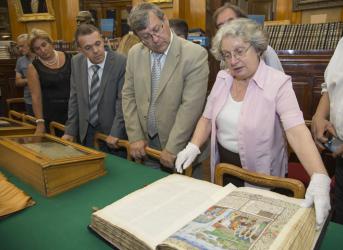Second Half of the 19th Century: Manuscripts in Western European Languages
The Department's collection of Western manuscripts was further enhanced in the course of the 19th century by the addition of the manuscripts from the private royal library, known as the Hermitage collection. The foreign part of the Hermitage collection consists of about 500 handwritten books in Latin and national languages of Western European countries, ranging from the 11th to the first half of the 19th centuries.
A whole group of rare manuscripts from the library of the Weissenau Monastery, founded in 1145 near Ravensburg (Germany), had been acquired by Emperor Alexander I. Only about 150 books from Weissenau Abbey are now in existence: 28 of them are now housed in the National Library of Russia and provide the basis of the Latin part of the Hermitage collection.
A unique example of medieval book art is a 14th century miniature Book of Hours - the smallest known manuscript that has size of 31x21 mm. Bought for the Hermitage Library by Nicholas I, the prayer is decorated with 10 miniatures (10x8 mm in size) in ornamental frames and 95 gold initial letters against a coloured background.But the undeniable masterpiece of book illumination in the Hermitage collection is the 15th century codex of the Grandes Chroniques de France. The manuscript also was purchased by Nicholas I. It was created between 1455 and 1457 for the Duke of Burgundy, Philip the Good, who vied with the French king for wealth and power. The huge volume is decorated with miniatures by the outstanding artist of the age, Simon Marmion, who his contemporaries called the Prince of Miniaturists.
Other important manuscripts of the 18th century are notable authorized copies of Denis Diderot's complete works (32 volumes) produced by author's request for Empress Catherine II. They arrived at Saint Petersburg along with Diderot's library.
In 1856, the Imperial Public Library received "pseudo-philosophical" works amassed by Count M. Vielgorsky. The collection is of the utmost importance for the history of mysticism and deserves particular attention. In addition to printed publications, it included 161 manuscripts in Russian and French, German and Latin.
In 1889, the Western stocks were enriched through acquisition of a small but very valuable collection of manuscripts assembled by Count A.G.Stroganov. It comprised 18 parchment manuscripts in Latin, French and Czech, adorned with miniatures and decorative ornaments. One of the French codices is a magnificent herbal produced for the younger brother of Rene d'Anjoux, Count Carl du Maine. After his death, the king Charles VIII of France became the new owner of the precious book.
